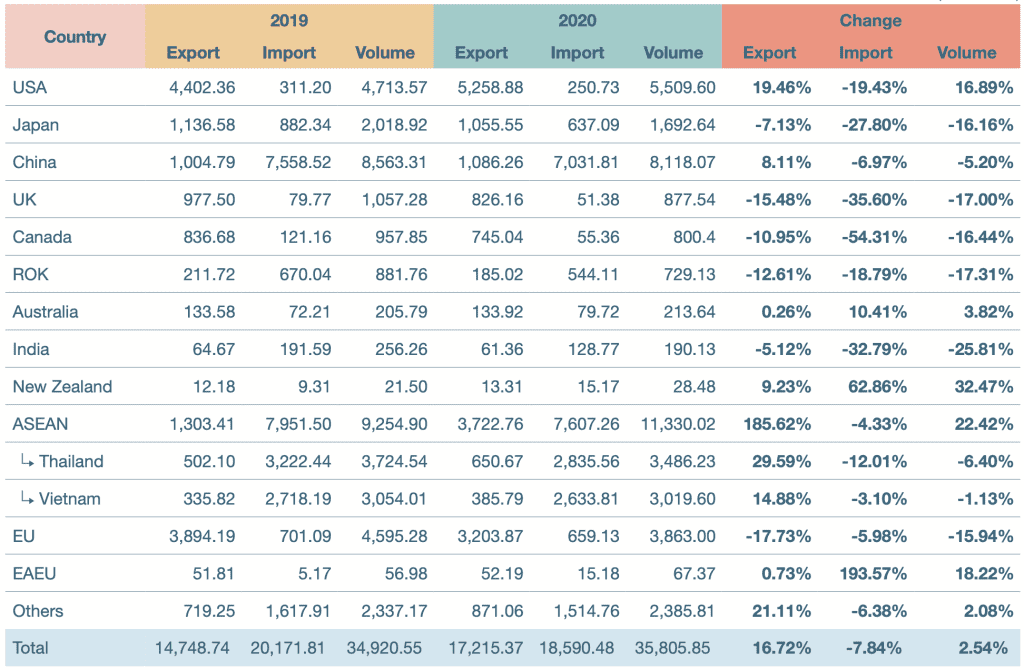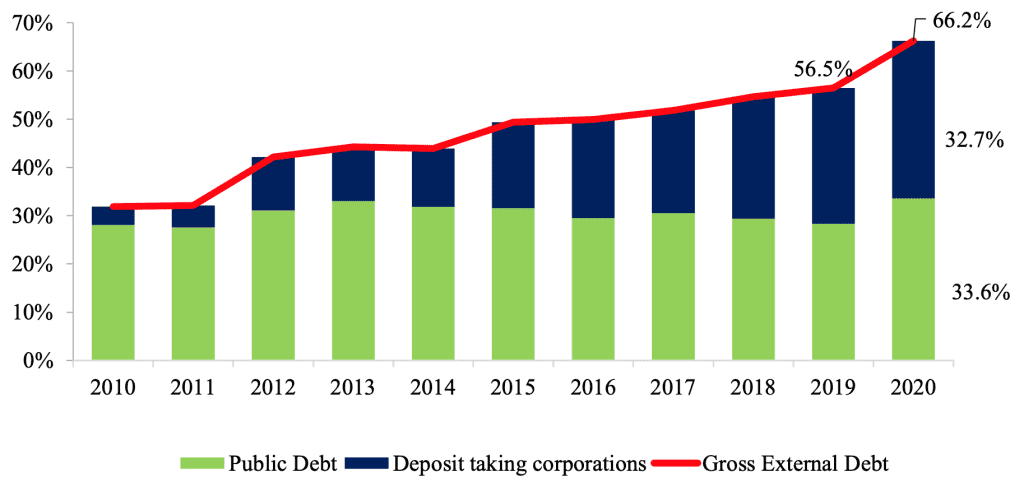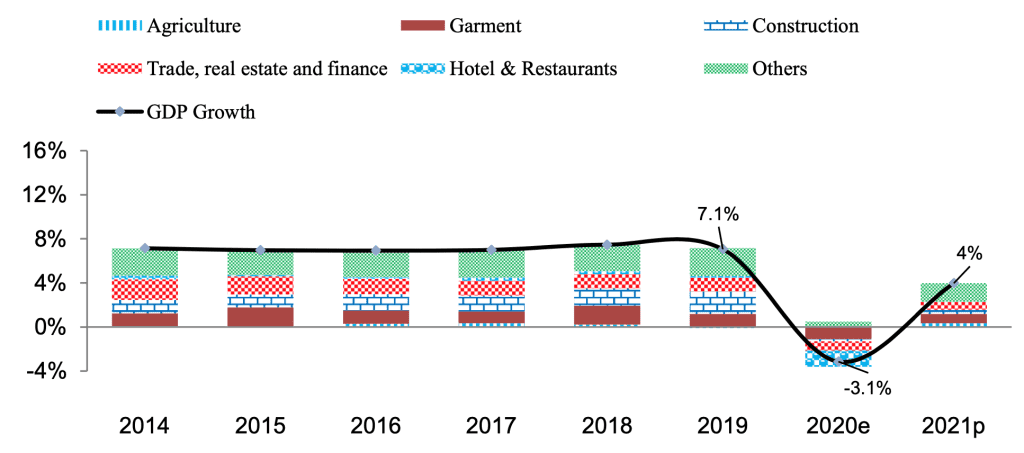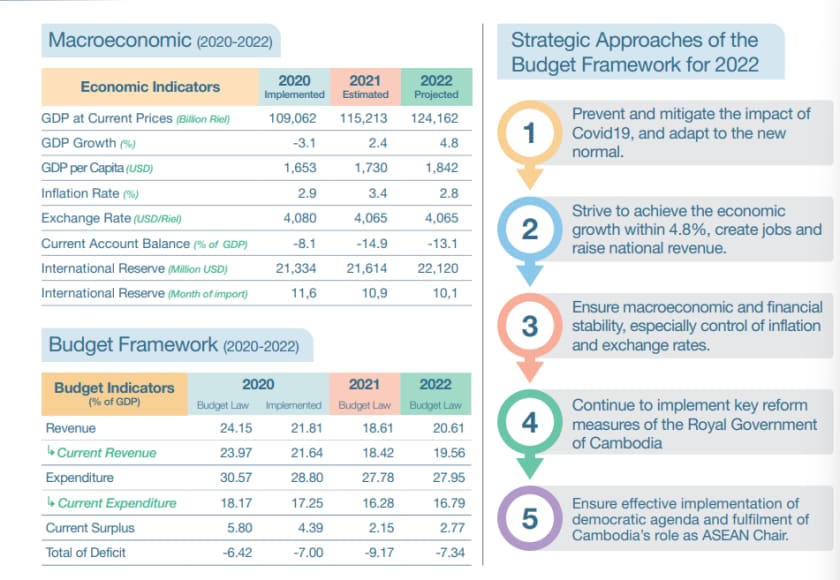There are many publications, reports, statistics and analyses on the performance of Cambodia’s economy. However, a foreign business or investor can often find it difficult and perhaps frustrating to know which figure or report is the most representative of the prevailing ground situation. In this section, we have sieved through various sources to provide, at a glance, facts, figures and analysis or considered opinion that are easy to understand and that hopefully will help elucidate the next step of your business consideration.
Cambodia Economy
According to the World Bank in Oct 2021, the economy of Cambodia has sustained an average annual growth rate of 7.7% from 1998 to 2019, making it one of the fastest-growing economies in the world. The Kingdom’s GDP in 2019 reached an all-time high of USD 27.089 billion. The services sector accounted for 38.9% of the GDP, industry for 34.2% and agriculture for 20.7%. In 2019, GDP per capita also reached a high of USD 1,700. According to the National Bank of Cambodia, GDP per capita will be upgraded to $1,842 in 2022, a 6.4 percent increase compared to $,1771 in 2021, $1,771.
The country has attained Lower Middle-Income (LMI) status in 2015 according to the World Bank’s classification and aims to recover from COVID-19 and become an upper-middle-income country by 2030.

The economy was significantly impacted by the COVID-19 pandemic in 2020, registering a contraction of 3.1%. However, according to an estimate from the World Bank’s publication “The Macro Poverty Outlook (MPO) for East Asia and the Pacific Report, Cambodia’s economy will return to positive growth at 4.5% in 2022 and 5.5% in 2023 in tandem with its socio-economic recovery on the back of ultra-high vaccination rates and the easing of travel restrictions for domestic and foreign travelers.

Cambodia is an active trading country and recorded a total export of USD 15.61 billion in the first eleven month of 2021. The country’s exports, composed mainly of garments and agricultural products, have increased steadily since the 1990s and account for more than 60% of the GDP. Exports of Cambodian agricultural products such as rice, rubber, cassava, mangoes, bananas, pepper, cashew nuts, corn, palm oil, and tobacco, among others have increased 7.98 million tons year-on-year and generated a gross revenue of USD 4.96 billion in 2021, an increase of 63.8 percent from the previous year.

Total exports in January and February 2022 showed a remarkable increase. Exports of Cambodian agricultural products such as rice, rubber, cassava, mangoes, bananas, pepper, cashew nuts, corn, palm oil, and tobacco, among others have increased 7.98 million tons year-on-year and generated a gross revenue of $4.96 billion in 2021, an increase of 63.8 percent from the previous year.
Cambodia’s geostrategic location in the heart of mainland Southeast Asia is within easy reach by flight from most major cities in Asia, by road through its border checkpoints with Thailand, Vietnam and Laos, and complemented by a deep-sea port in Sihanoukville, an autonomous port in Phnom Penh and numerous smaller river ports throughout Cambodia’s provinces.
Businesses and investors have yet to fully optimize the tariff exemption/preference schemes that the developing country enjoys from the European Union Everything-But-Arms (EBA)and the US Generalized Scheme of Preferences Plus (GSP+), and the Free Trade Agreements (FTA) with China and South Korea.
Cambodia’s public debt which consists solely of external debt is rising but the risk of debt distress remains low due largely to the authorities’ borrowing principle of only contracting external debt on concessional terms. Cambodia’s debt-to-GDP ratio reached 33.6 percent of GDP (US$8.8 billion in outstanding debt) in 2020 and is projected to increase to 35.2 percent of GDP (US$9.6 billion) in 2021. Unlike during the past several years, when the largest contributions to loan disbursement growth came mostly from bilateral creditors such as China and France, in 2020, the contribution of loan disbursement by the ADB was the largest, accounting for 30.4 percentage points of the 40.3 percent increase in total loan disbursement. Disbursement from the ADB peaked at US$421.9 million in 2020, up from US$159.11 million in 2019. The contribution of debt disbursement from Japan was next, accounting for 7.6 percentage points (US$149.8 million) of the increase, followed by those from China and the World Bank, accounting 4.0 percentage points and 3.5 percentage points, respectively.

A new Law on Government Securities was adopted in December 2020, paving the way for issuance of the first government securities in the near future for the establishment of a domestic debt market and providing an overall legal and regulatory framework for issuing, trading, and managing government securities to support public debt management and debt sustainability. When established, the domestic debt market will help gradually diversify financing sources with a shift toward public domestic debt, while promoting domestic savings.
Supplementary
Real GDP Growth Contribution

Cambodia’s Budget in Brief 2021

Budget Framework (2021)

Feel free to enquire with the Aquarii team should you need further advice.
If you are looking for a more nuanced insight or advice in terms of other indicators/observations not commonly found in publications for a better understanding of how a business or investor can navigate the local environment or seek out collaboration opportunities and trustworthy partners, get in touch with our team at Aquarii. Ask to speak to our CEO if you wish to know why he has decided to make Cambodia his 2nd home, perhaps the strongest testament of his conviction in the potential and opportunities in the Kingdom.






